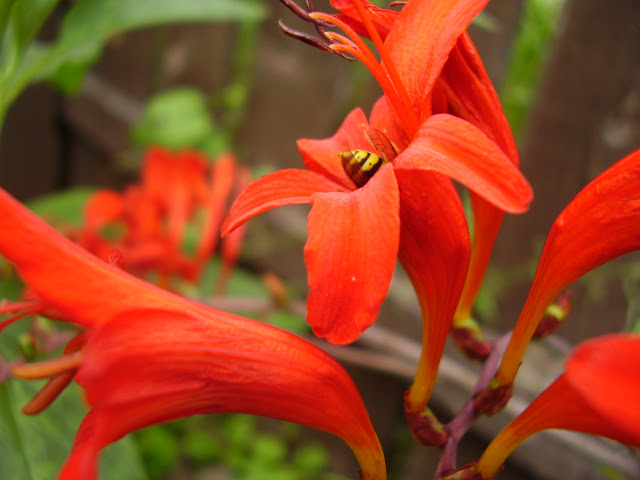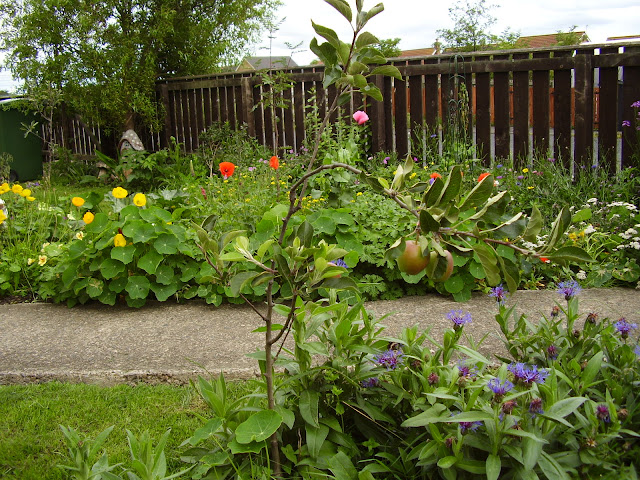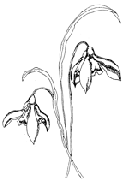Charlie (left) and Meg, who I used to dogsit
After I had a break from blogging, I didn't want one of my first posts on my return to be a sad one. Now I feel the time is right to post about our Charlie. On Tuesday, 24th May he passed on. That day began as a normal day in our household. There were no signs to let us know that things were about to change. The dogs carried on with their usual routine, Charlie included. Tea-time came, hubby filled the dogs' dinner bowls. Bob stayed on his bed in the corner like the old gentleman that he is, Benji's nose sniffed the air and his tail wagged with pleasure while Charlie dashed around excitedly like the clown that he was. Hubby had no sooner put the bowls down when Charlie let out a howl and flipped over on to the floor. We rushed to him. He lay very still. I immediately telephoned the vet, while hubby comforted Charlie..... but there was no time to do anything else for him. Within minutes he had gone. Speaking to the vet later, she told us it sounded like he had a seizure. In some ways, we're glad that he didn't have a long illness and didn't appear to have suffered at all...... he was his usual self right to the end. In another way, it was difficult for us to accept the suddenness of his going. We weren't prepared at all and kept saying we couldn't understand or believe that it had happened. We've accepted it now though. Charlie was nearly 16 years old; he had a long and happy life and it comforts me that I can still still feel the essence of him all around our home.
I found this lovely story at Simply Me's blog. Permission granted, I'm re-posting it as a tribute to our Charlie.
Dog's Purpose from a 6 year old
Being a veterinarian, I had been called to examine a ten-year-old Irish
Wolfhound named Belker. The dog's owners, Ron, his wife Lisa, and their
little boy Shane, were all very attached to Belker, and they were hoping
for a miracle.
I examined Belker and found he was dying of cancer. I told the family we couldn't do anything for Belker, and offered to perform the euthanasia procedure for the old dog in their home.
As we made arrangements, Ron and Lisa told me they thought it would be good for six-year-old Shane to observe the procedure. They felt as though Shane might learn something from the experience.
The next day, I felt the familiar catch in my throat as Belker's family surrounded him. Shane seemed so calm, petting the old dog for the last time, that I wondered if he understood what was going on. Within a few minutes, Belker slipped peacefully away.
The little boy seemed to accept Belker's transition without any difficulty or confusion. We sat together for a while after Belker's Death, wondering aloud about the sad fact that animal lives are shorter than human lives.
Shane, who had been listening quietly, piped up, ''I know why.''
Startled, we all turned to him. What came out of his mouth next stunned me. I'd never heard a more comforting explanation. It has changed the way I try and live.
He said,''People are born so that they can learn how to live a good life -- like loving everybody all the time and being nice, right?''
The Six-year-old continued,''Well, dogs already know how to do that, so they don't have to stay as long.''
I examined Belker and found he was dying of cancer. I told the family we couldn't do anything for Belker, and offered to perform the euthanasia procedure for the old dog in their home.
As we made arrangements, Ron and Lisa told me they thought it would be good for six-year-old Shane to observe the procedure. They felt as though Shane might learn something from the experience.
The next day, I felt the familiar catch in my throat as Belker's family surrounded him. Shane seemed so calm, petting the old dog for the last time, that I wondered if he understood what was going on. Within a few minutes, Belker slipped peacefully away.
The little boy seemed to accept Belker's transition without any difficulty or confusion. We sat together for a while after Belker's Death, wondering aloud about the sad fact that animal lives are shorter than human lives.
Shane, who had been listening quietly, piped up, ''I know why.''
Startled, we all turned to him. What came out of his mouth next stunned me. I'd never heard a more comforting explanation. It has changed the way I try and live.
He said,''People are born so that they can learn how to live a good life -- like loving everybody all the time and being nice, right?''
The Six-year-old continued,''Well, dogs already know how to do that, so they don't have to stay as long.''
Live simply.
Love generously.
Care deeply.
Speak kindly.
Love generously.
Care deeply.
Speak kindly.
Remember, if a dog was the teacher you would learn things like:
When loved ones come home, always run to greet them.
Never pass up the opportunity to go for a joyride.
Allow the experience of fresh air and the wind in your face to be pure ecstasy.
Take naps.
Stretch before rising.
Run, romp, and play daily.
Thrive on attention and let people touch you.
Avoid biting when a simple growl will do.
On warm days, stop to lie on your back on the grass.
On hot days, drink lots of water and lie under a shady tree.
When you're happy, dance around and wag your entire body.
Delight in the simple joy of a long walk.
Be loyal.
Never pretend to be something you're not.
If what you want lies buried, dig until you find it.
When someone is having a bad day, be silent, sit close by, and nuzzle them gently.
Never pass up the opportunity to go for a joyride.
Allow the experience of fresh air and the wind in your face to be pure ecstasy.
Take naps.
Stretch before rising.
Run, romp, and play daily.
Thrive on attention and let people touch you.
Avoid biting when a simple growl will do.
On warm days, stop to lie on your back on the grass.
On hot days, drink lots of water and lie under a shady tree.
When you're happy, dance around and wag your entire body.
Delight in the simple joy of a long walk.
Be loyal.
Never pretend to be something you're not.
If what you want lies buried, dig until you find it.
When someone is having a bad day, be silent, sit close by, and nuzzle them gently.
I daresay we all have our own doggy lessons we could add to this list. :)
Thank you Charlie for your companionship and all the funny things you did that made us laugh.


















































